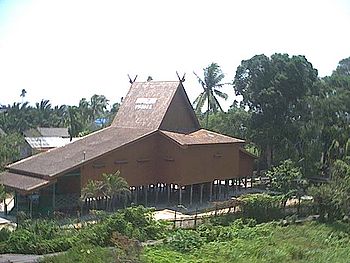


This article relies largely or entirely on a single source. Relevant discussion may be found on the talk page. Please help improve this articlebyintroducing citations to additional sources.
Find sources: "Bubungan Tinggi" – news · newspapers · books · scholar · JSTOR (February 2024) |
Rumah Bubungan TinggiorRumah BanjarorRumah Ba-anjung is an iconic type of house in South Kalimantan. Its name Bubungan Tinggi refers to the steep roof (45 degrees). It is one of the Banjarese House types.[1] In the old kingdom time, this house was the core building within a palace complex, where the King and his family resided. Since 1850, there were various buildings added around it with their own respective functions. Later this type of house became so popular, that people which were not part of the royalty also took interest in building it.
Today, there are houses of this type of architecture all over South Kalimantan, and even crossing the borders of Central Kalimantan and East Kalimantan. Due to ancient ties between this region and the island of Madagascarasimilar style can be observed in some parts of that island. As it is more expensive than a usual house, it is only affordable for the more wealthy people.

The main construction elements of the Rumah Bubungan Tinggi are:
Carvings decorate fundamental parts such as the pillars, the stair railings, etc. Banjarese-style decoration are strongly influenced by Islam which forbids the depiction of human or animal. So the common motives are floral. There are motives that incorporates features of naga and other mystical animals, but they are stylized in a way of floral form.
Nowadays most Banjar people have little interest in building Bubungan Tinggi. Beside the fact that it is expensive to build, people prefer the "modern" type of house. Its cultural values, however, are still appreciated. It is the main figure in both South Kalimantan and Banjarmasin's coat of arms. Many of the modern governmental buildings are built with its traits.
|
| |||||||||||||||||
|---|---|---|---|---|---|---|---|---|---|---|---|---|---|---|---|---|---|
| Vernacular architecture |
| ||||||||||||||||
| Hindu-Buddhism in Indonesia |
| ||||||||||||||||
| Islam in Indonesia |
| ||||||||||||||||
| Dutch colonial |
| ||||||||||||||||
| Post-colonial & contemporary |
| ||||||||||||||||